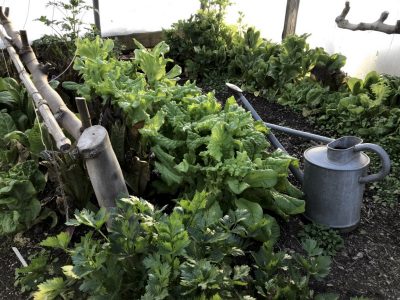Midsummer “To Do” List
Maintenance, Pruning
For many gardeners, spring is the critical gardening season, what with preparing the soil, starting seedlings, setting out transplants, pruning, watching and staying prepared for late frosts and . . . In my view, right now is just as crucial, and for an equal number of reasons.
True, a 90 degree day with high humidity doesn’t exactly pull you out to the garden to putter around in blazing sunlight. But early mornings around here are mostly cool, calm, and beautiful.
Much of what needs to be done is regular maintenance. Pruning tomatoes, for instance.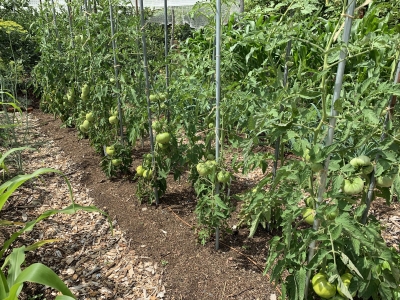 I train my tomato plants to stakes and single stems, which allows me to set plants only 18 inches apart and harvest lots of fruit by utilizing the third dimension: up. At least weekly, I snap (if early morning, when shoots are turgid) or prune (later in the day, when shoots are flaccid) off all suckers and tie the main stems to their metal conduit supports.
I train my tomato plants to stakes and single stems, which allows me to set plants only 18 inches apart and harvest lots of fruit by utilizing the third dimension: up. At least weekly, I snap (if early morning, when shoots are turgid) or prune (later in the day, when shoots are flaccid) off all suckers and tie the main stems to their metal conduit supports.
Espalier is the training of trees to two dimensions whereby the tracery of the stems is as decorative a plant feature as are the leaves, flowers, and/or fruits. To maintain that tracery of branches, my espaliered Asian pears need frequent pruning. 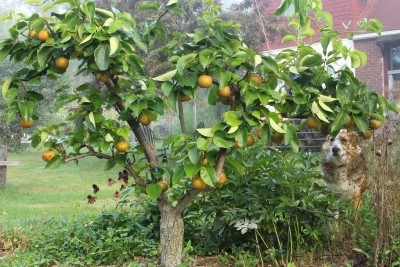 I lop wayward shoots either right back to their origin or, in hope of their forming “spurs” on which will hang future fruits, back to the whorl of leaves near the bases of the shoots.
I lop wayward shoots either right back to their origin or, in hope of their forming “spurs” on which will hang future fruits, back to the whorl of leaves near the bases of the shoots.
The response of the pear trees depends on the weather, which is unpredictable. Dry sunny weather is conducive to spurs. Rainy weather coaxes, instead, new shoots pop out right where I cut back old shoots. I think.
Maintenance, Water
Whether or not the weather is dry, rampant growing plants quickly suck the soil dry. So I also keep attentive to watering this time of year. The vegetable garden and potted plants are the neediest in this respect; fortunately, they demand little from me to do because a timer turns its drip irrigation system on and off automatically. All I have to do is to periodically check to make sure drippers are all dripping. 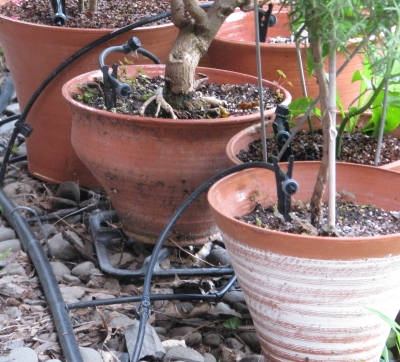 Newly planted trees and shrubs are another story. This first year, while their roots are spreading out in the ground, is critical for them. I make a list of these plants each spring and then water them weekly by hand all summer long unless the skies do the job for me (as measured in a rain gauge because what seems like a heavy rainfall often has dropped surprisingly little water).
Newly planted trees and shrubs are another story. This first year, while their roots are spreading out in the ground, is critical for them. I make a list of these plants each spring and then water them weekly by hand all summer long unless the skies do the job for me (as measured in a rain gauge because what seems like a heavy rainfall often has dropped surprisingly little water).
A one-inch depth of water is needed to wet a soil about a half a foot deep. I provide this with 3/4 gallon of water per estimated square foot spread of the roots.
Fall preps
Sowing seeds and setting out transplants isn’t only a spring gardening activity. Tomatoes, peppers, eggplants, cucumbers, and other summer vegetables peter out during the shorter, cooler days of late summer and early fall. But there are plenty of vegetables that enjoy growing conditions that time of year.
Some of the fall vegetables need to be sown now to be large enough to mature in fall. No need to provide space for them by digging out tomatoes, peppers, or any other summer vegetables. I sow endive, kale, lettuce, Chinese cabbage, and, if I could stomach it, cauliflower seeds in midsummer in seed flats. Once they sprout I “prick them out” into individual cells of automatic watering GrowEase trays for later transplanting. 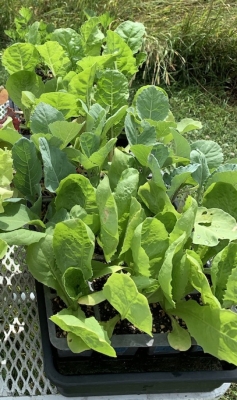 Not only vegetables get this treatment. Buy a packet of seeds of delphinium, pinks, or some other perennial, sow them now, overwinter them in a cool place with good light, or a cold (but not too cold) place with very little light, and the result is enough plants for a sweeping field of blue or pink next year. Sown in the spring, they won’t bloom until their second season even though they’ll need lots of space that whole first season.
Not only vegetables get this treatment. Buy a packet of seeds of delphinium, pinks, or some other perennial, sow them now, overwinter them in a cool place with good light, or a cold (but not too cold) place with very little light, and the result is enough plants for a sweeping field of blue or pink next year. Sown in the spring, they won’t bloom until their second season even though they’ll need lots of space that whole first season.
Cuttings are another way to propagate plants this time of year. Early this morning, when cells were plump with water, I made cuttings of hardy kiwifruit and begonia.
And, Yes, Weeds
Weeds can make all this pruning, watering, and seeding for naught. Clear ground is needed in which to eventually set my cabbage and kale transplants. Weeds stealing water and nutrients, even sunlight, won’t let plants grow at their best. They’ll also promote disease by preventing free flow of air; fungi fester under damp conditions. 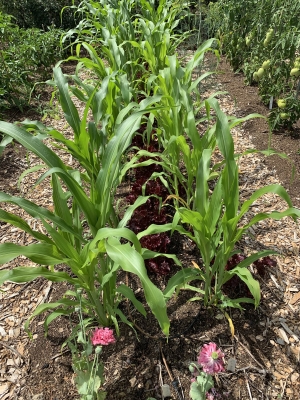 Every time I look at a weed, I’m thinking how it’s either sending roots further afield underground or is flowering (or will flower) to scatter its seed. Much of gardening isn’t about the here and now, so I also weed now for less weeds next season. It’s worth it.
Every time I look at a weed, I’m thinking how it’s either sending roots further afield underground or is flowering (or will flower) to scatter its seed. Much of gardening isn’t about the here and now, so I also weed now for less weeds next season. It’s worth it.

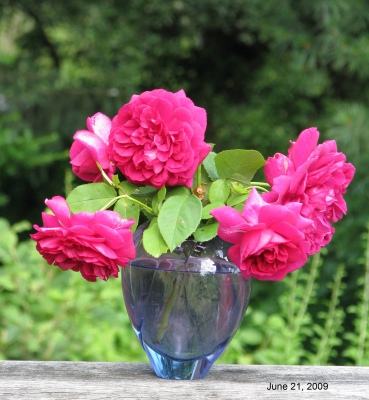 After a few years of watching the weakened plant recover each season, I made cuttings from some of the stems. The cuttings rooted and the new plants, rather than being grafted, were then growing on their own roots. Even a cold winter wouldn’t kill the roots, living in soil where temperatures are moderated. If the stems died back to ground level, new sprouts would still sport those dark, red blossoms.
After a few years of watching the weakened plant recover each season, I made cuttings from some of the stems. The cuttings rooted and the new plants, rather than being grafted, were then growing on their own roots. Even a cold winter wouldn’t kill the roots, living in soil where temperatures are moderated. If the stems died back to ground level, new sprouts would still sport those dark, red blossoms.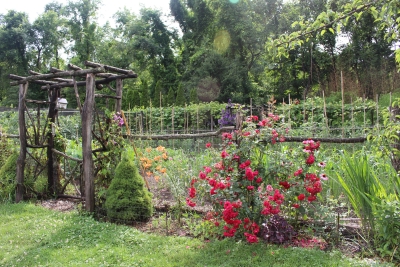
 Putting up the net always brings the words of fruit breeder Dr. Elwyn Meader to mind. When I visited him back in the 1980s, the old New Englander, still active in his retirement and growing about an acre of blueberries, among other crops, recounted in his slow, New Hampshire accent, “It takes a patient man to net an acre of blueberries.” Covering my two plantings encompassing a total of about a thousand square feet always creates a little tension.
Putting up the net always brings the words of fruit breeder Dr. Elwyn Meader to mind. When I visited him back in the 1980s, the old New Englander, still active in his retirement and growing about an acre of blueberries, among other crops, recounted in his slow, New Hampshire accent, “It takes a patient man to net an acre of blueberries.” Covering my two plantings encompassing a total of about a thousand square feet always creates a little tension.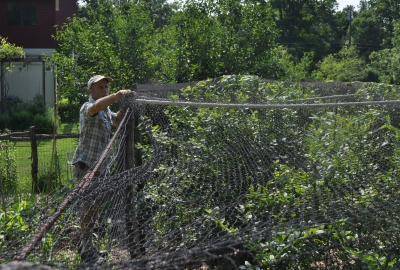 I now feel like a captain setting sail on an old sailing vessel, with all the sails trim and masts set. Except rather than sails and masts, it’s a blueberry net that’s spread tightly over the permanent, 7-foot-high perimeter of locust posts and side walls of anti-bird, plastic mesh. That netting covers 16 bushes within a 25 foot by 25 foot area. Rebar through holes near the tops of the locust posts keeps that side wall mesh taught and 18” high chicken wire along the bottom keeps rabbits, which love to teethe on that plastic mesh, from doing so.
I now feel like a captain setting sail on an old sailing vessel, with all the sails trim and masts set. Except rather than sails and masts, it’s a blueberry net that’s spread tightly over the permanent, 7-foot-high perimeter of locust posts and side walls of anti-bird, plastic mesh. That netting covers 16 bushes within a 25 foot by 25 foot area. Rebar through holes near the tops of the locust posts keeps that side wall mesh taught and 18” high chicken wire along the bottom keeps rabbits, which love to teethe on that plastic mesh, from doing so.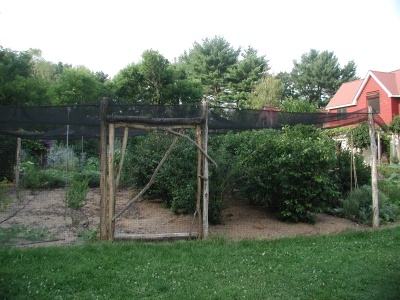 Don’t worry about the birds. They get their fill of berries elsewhere. I don’t net my lowbush blueberries, nor my mulberries or gumis. Birds don’t usually share the mulberries or gumis with me. This year, for some reason, they are sharing.
Don’t worry about the birds. They get their fill of berries elsewhere. I don’t net my lowbush blueberries, nor my mulberries or gumis. Birds don’t usually share the mulberries or gumis with me. This year, for some reason, they are sharing. Juneberries are related to apples and pears, not blueberries, and share some of their kin’s pest problems. Especially in my garden. They’re one fruit that didn’t grow well for me so, years ago, I finally dug the plants up.
Juneberries are related to apples and pears, not blueberries, and share some of their kin’s pest problems. Especially in my garden. They’re one fruit that didn’t grow well for me so, years ago, I finally dug the plants up.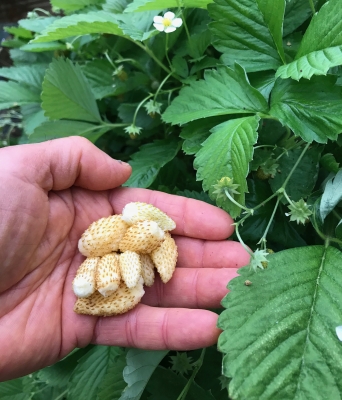 You should be scratching your head by now. Strawberries that are white when ripe? Strawberries perhaps ready for harvest in early May here in the Hudson Valley?
You should be scratching your head by now. Strawberries that are white when ripe? Strawberries perhaps ready for harvest in early May here in the Hudson Valley?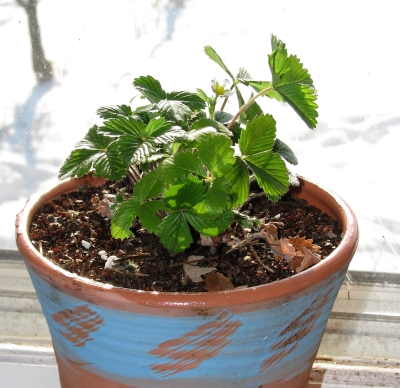 And no, the plants hadn’t resided in my home and aren’t now in my greenhouse to protect them from winter cold. I wanted an earlier crop. I also grow them outdoors.
And no, the plants hadn’t resided in my home and aren’t now in my greenhouse to protect them from winter cold. I wanted an earlier crop. I also grow them outdoors.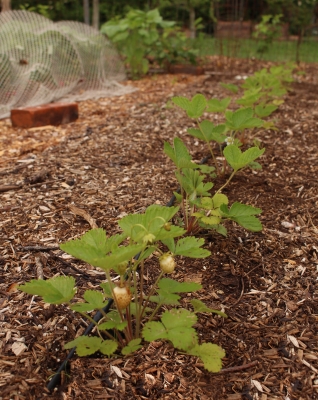
 A planting can be started from plants or seeds, the latter started just as are tomatoes. Plants grown from seeds planted in spring will begin bearing their first season.
A planting can be started from plants or seeds, the latter started just as are tomatoes. Plants grown from seeds planted in spring will begin bearing their first season.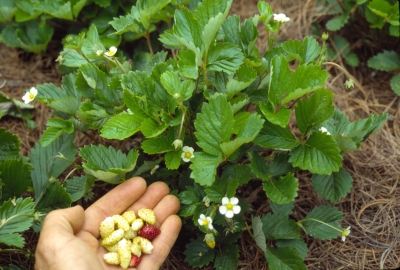 It turned out that all the red-fruited ones were similar, as were the white-fruited ones. For me, the white ones definitely had better flavor. And the flavor could be enjoyed. Why? Because until they are dead ripe, alpine strawberries have taste somewhat akin to cotton soaked in lemon juice. Problem is that birds are very attracted to, and eat, the red fruits no care as to whether or not the berries are dead ripe.
It turned out that all the red-fruited ones were similar, as were the white-fruited ones. For me, the white ones definitely had better flavor. And the flavor could be enjoyed. Why? Because until they are dead ripe, alpine strawberries have taste somewhat akin to cotton soaked in lemon juice. Problem is that birds are very attracted to, and eat, the red fruits no care as to whether or not the berries are dead ripe.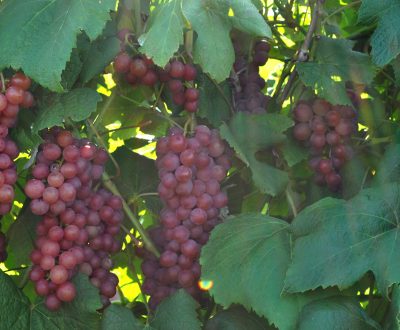
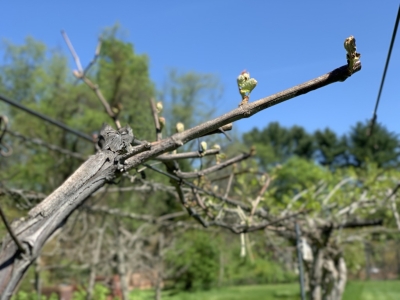
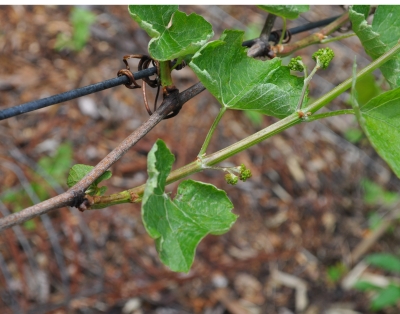

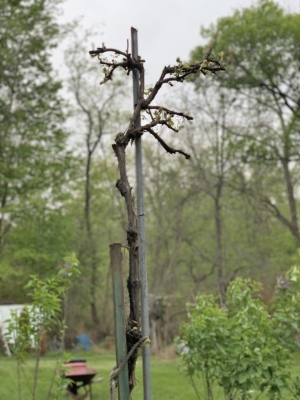 A spur-pruned vine might instead sport a permanent trunk topped by two arms — permanent arms, called “cordons,” in this case — that run in opposite directions along a trellis wire.
A spur-pruned vine might instead sport a permanent trunk topped by two arms — permanent arms, called “cordons,” in this case — that run in opposite directions along a trellis wire.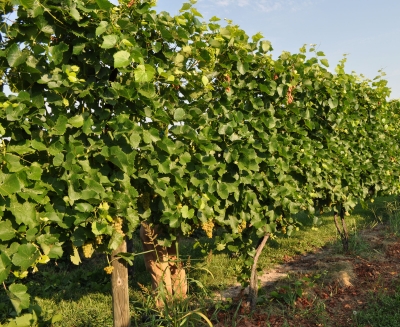
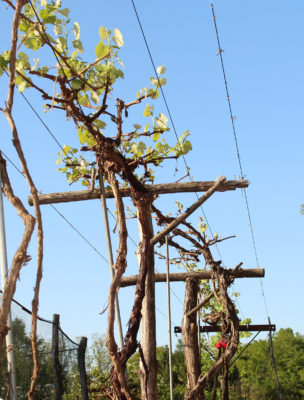


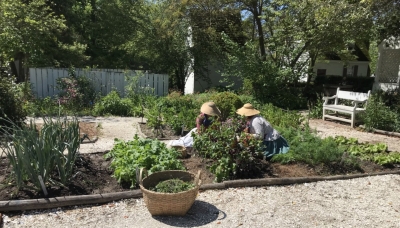 Flowering meads of herbs, flowers, and grasses blanketed the ground beneath most of the orchards, providing — probably unknown back in colonial days — forage for beneficial insects to help protect crop plants.
Flowering meads of herbs, flowers, and grasses blanketed the ground beneath most of the orchards, providing — probably unknown back in colonial days — forage for beneficial insects to help protect crop plants.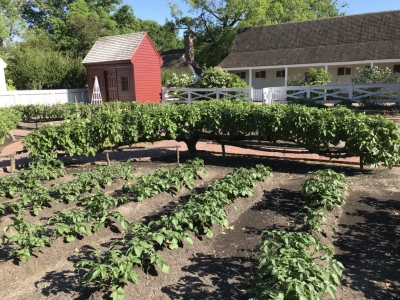
 My own home is brick; even a few four-foot-high walls around my vegetable garden and in other areas would improve the general appearance — and provide, warmer microclimates for cold-tender plants or early harvests. Not that the rustic locust fencing and arbors enclosing my vegetable garden look unsightly . . . but I’d like some brick walls.
My own home is brick; even a few four-foot-high walls around my vegetable garden and in other areas would improve the general appearance — and provide, warmer microclimates for cold-tender plants or early harvests. Not that the rustic locust fencing and arbors enclosing my vegetable garden look unsightly . . . but I’d like some brick walls.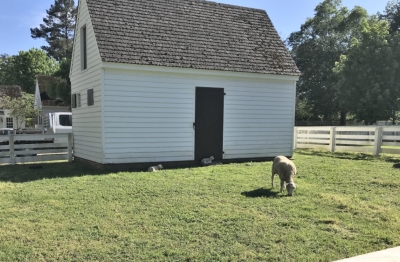
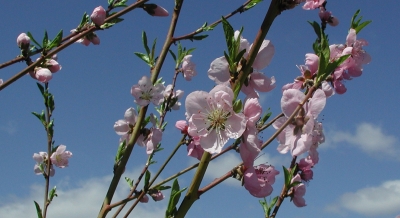 I mentioned flower buds, so these plants I’m pruning are mature, bearing plants. The objectives and, hence, pruning of a young tree are another ball game. As is renovative pruning, which is the pruning of long-neglected trees.
I mentioned flower buds, so these plants I’m pruning are mature, bearing plants. The objectives and, hence, pruning of a young tree are another ball game. As is renovative pruning, which is the pruning of long-neglected trees.
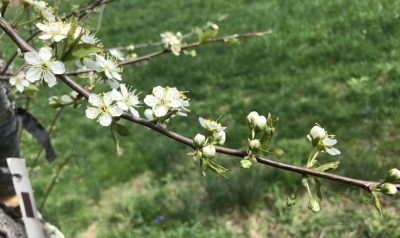


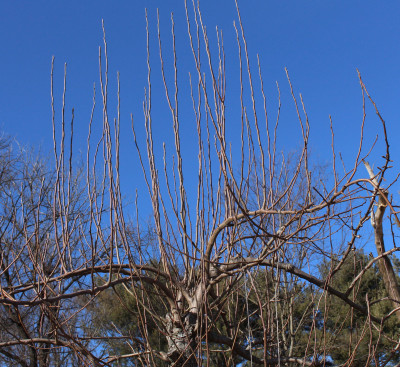

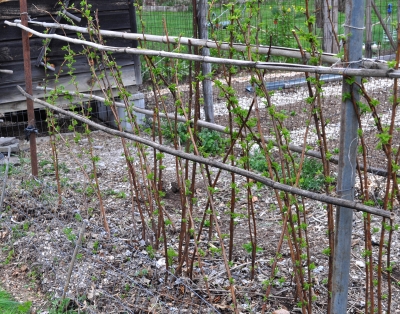

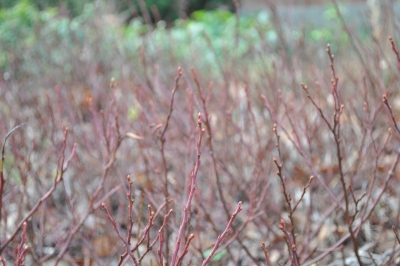
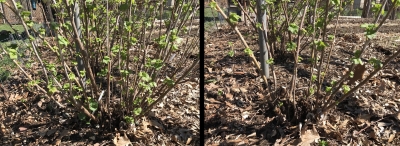
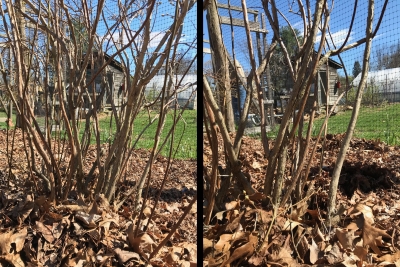
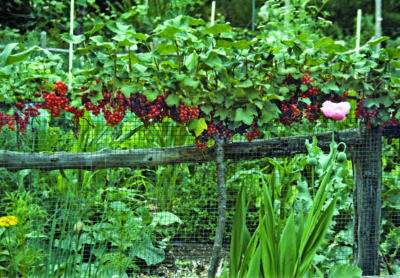
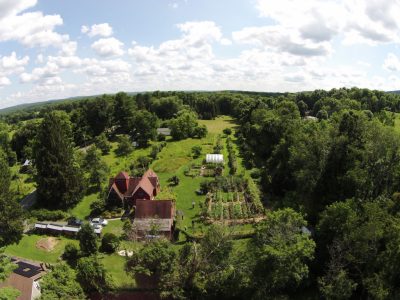
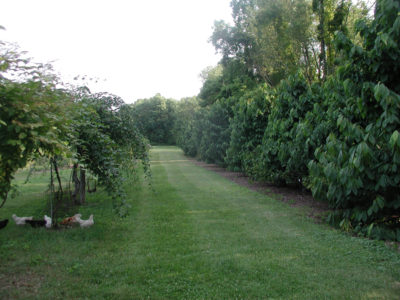
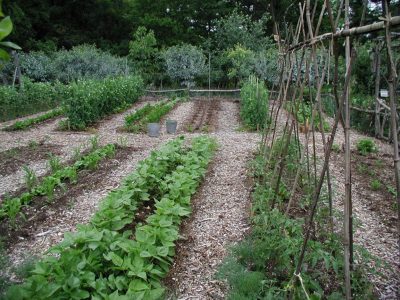 And what about winter? A greenhouse full of salad and cooking greens solved that problem, in addition to providing figs in summer and early and late season cucumbers.
And what about winter? A greenhouse full of salad and cooking greens solved that problem, in addition to providing figs in summer and early and late season cucumbers.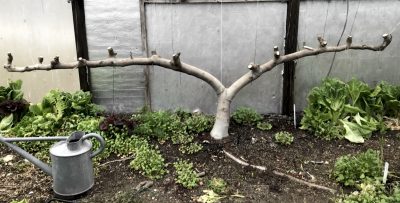
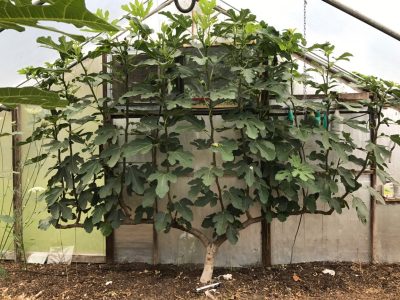
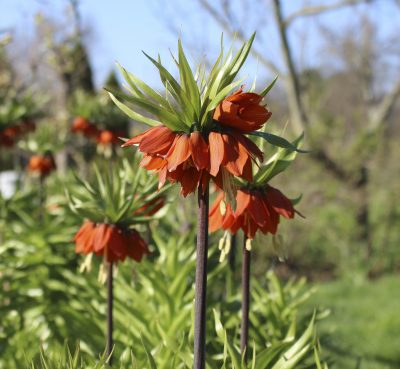
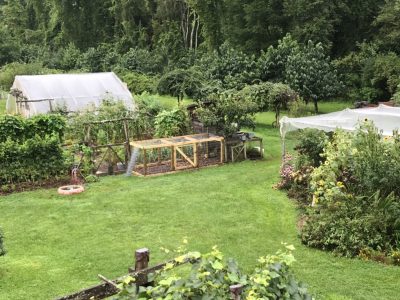
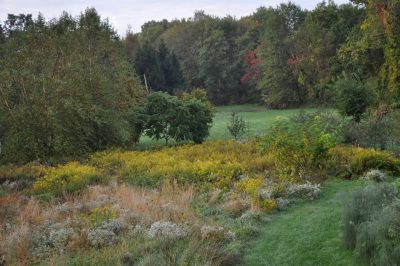
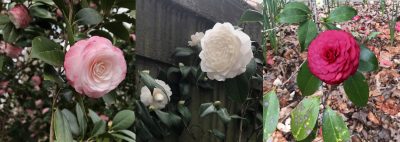
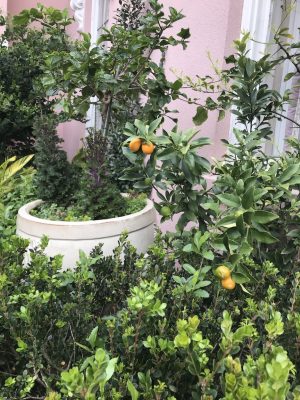 But winter low temperatures in Charleston rarely dip even to freezing but kumquat trees are hardy into the ‘teens. A few citrangequats — trigeneric hybids of kumquat, trifoliate orange, and sweet orange — that I stole from a tree proved to be tasty with sweet, edible rind enclosing a pleasingly tart interior.
But winter low temperatures in Charleston rarely dip even to freezing but kumquat trees are hardy into the ‘teens. A few citrangequats — trigeneric hybids of kumquat, trifoliate orange, and sweet orange — that I stole from a tree proved to be tasty with sweet, edible rind enclosing a pleasingly tart interior.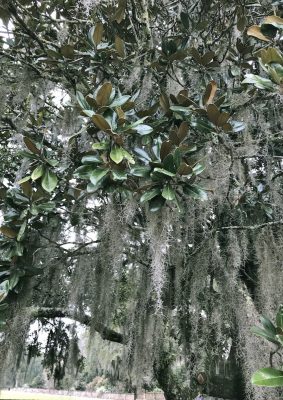
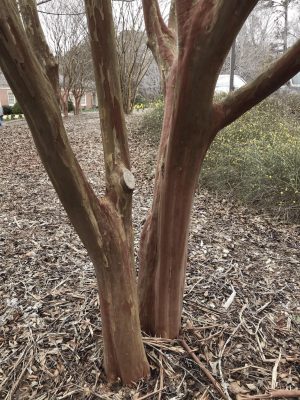
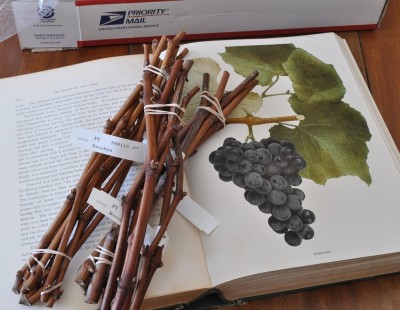
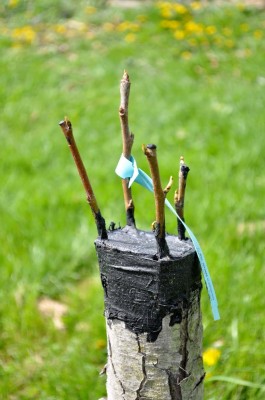 Grape sticks got plunged into the ground where they grew their own roots, shoots, and everything else. Apples aren’t so amenable to growing their own roots.
Grape sticks got plunged into the ground where they grew their own roots, shoots, and everything else. Apples aren’t so amenable to growing their own roots.
